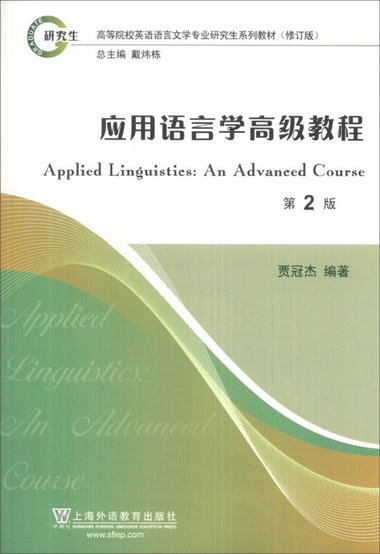| | | | 應用語言學高級教程(第2版)/高等院校英語語言文學專業研究生繫 | | 該商品所屬分類:圖書 -> 上海外語教育出版社 | | 【市場價】 | 254-368元 | | 【優惠價】 | 159-230元 | | 【作者】 | 賈冠傑戴煒棟 | | 【出版社】 | 上海外語教育出版社 | | 【ISBN】 | 9787544633864 | | 【折扣說明】 | 一次購物滿999元台幣免運費+贈品
一次購物滿2000元台幣95折+免運費+贈品
一次購物滿3000元台幣92折+免運費+贈品
一次購物滿4000元台幣88折+免運費+贈品
| | 【本期贈品】 | ①優質無紡布環保袋,做工棒!②品牌簽字筆 ③品牌手帕紙巾
|
|
| 版本 | 正版全新電子版PDF檔 | | 您已选择: | 正版全新 | 溫馨提示:如果有多種選項,請先選擇再點擊加入購物車。*. 電子圖書價格是0.69折,例如了得網價格是100元,電子書pdf的價格則是69元。
*. 購買電子書不支持貨到付款,購買時選擇atm或者超商、PayPal付款。付款後1-24小時內通過郵件傳輸給您。
*. 如果收到的電子書不滿意,可以聯絡我們退款。謝謝。 | | | |
| | 內容介紹 | |

出版社:上海外語教育出版社 ISBN:9787544633864 版次:2 商品編碼:11364321 品牌:外教社 包裝:平裝 叢書名:高等院校英語語言文學專業研究生繫列教材 外文名稱:Applied 開本:16開 出版時間:2013-09-01 用紙:膠版紙 頁數:241 字數:336000 正文語種:中文,英文 作者:賈冠傑,戴煒棟
" 編輯推薦 《應用語言學高級教程(第2版)/高等院校英語語言文學專業研究生繫列教材(修訂版)》是我國首套英語語言文學專業研究生教材,強調科學性、繫統性、規範性、先進性和實用性,力求體現理論與應用相結合,介紹與研究相結合,史與論相結合,原創與引進相結合,全面融會貫通。每一種教材都能夠反映出該研究領域的新理論、新方法和新成果。《應用語言學高級教程(第2版)/高等院校英語語言文學專業研究生繫列教材(修訂版)》涵蓋了語言學、語言教學、文學理論、原著選讀等領域,可作為我國英語語言文學專業研究生的主干教材,也適合對該領域學術研究感興趣的學習者使用。 內容簡介 應用語言學是一門獨立的新興交叉學科,自20世紀40年代以來,得到了迅猛的發展,如今已經是語言學研究中的一個熱門領域。《應用語言學高級教程(第2版)/高等院校英語語言文學專業研究生繫列教材(修訂版)》簡要回顧了應用語言學的發展歷程,詳細講解了這一學科的基本概念,釐清了應用語言學的含義,並分章節介紹了本學科與其他語言學分支學科之間的聯繫。第2版在前一版的基礎上,增添了近年來應用語言學領域的最新研究成果,全面反映了本學科的研究動態。 目錄 Chapter 1 Introduction
1.1 What Is Applied Linguistics?
1.2 Fields ofApplied Linguistics
1.3 Summary
Chapter 2 Development of Applied Linguistics
2.1 A BriefHistory of Applied Linguistics
2.2 Changes in Applied Linguistic Practice
2.3 Applied Linguistics in China
2.4 Somejournals of Applied Linguistics
2.5 Summary
Chapter 3 Applied Linguistics and Language
3.1 What Is Language?
3.2 Why Do We Study Language?
3.3 A General View of Language and Individual Languages
3.4 Identities ofLanguage
3.5 Summary
Chapter 4 Applied Linguistics and Linguistics
4.1 Sub-fields ofLinguistics
4.2 What Do We Study in Linguistics?
4.3 Is Linguistics Applied?
4.4 Relationship between Applied Linguistics and Linguistics
4.5 Summary
Chapter 5 Applied Linguistics and Language Learning
5.1 Language Problems and Applied Linguistics
5.2 Methodology ofApplied Linguistics
5.3 Multimedia Learning
5.4 Cooperative/Collaborative Learning
5.5 Learning to Communicate through Communication
5.6 Summary
Chapter 6 Applied Linguistics and Psycholinguistics
6.1 What is Psycholinguistics?
6.2 A Brief History of Psycholinguistics
6.3 Fields of Psycholinguistics
6.4 Relationship between Psycholinguistics and Applied Linguistics
6.5 Key Issues in the Multilingual Processing
6.6 Summary
Chapter 7 Applied Linguistics and Sociolinguistics
7.1 What is Sociolinguistics?
7.2 Origin and Rise of Sociolinguistics
7.3 Sociolinguistics and Second Language Acquisition
7.4 Sociolinguistics and Second Language Teaching
7.5 What is the Relationship between Applied Linguistics and Sociolinguistics?
7.6 Summary
Chapter 8 Applied Linguistics and Corpus Linguistics
8.1 Basics ofCorpus Linguistics
8.2 Basics ofAnalyzing a Corpus
8.3 Phraseology
8.4 Applications of Corpora in Applied Linguistics
8.5 Summary
Chapter 9 Applied Linguistics and Second Language Acquisition
9.1 Second Language and Foreign Language
9.2 Second Language Acquisition
9.3 Brief History of Second Language Acquisition
9.4 Applied SLA and SLAApplied
9.5 Relationship between Applied Linguistics and Second Language Acquisition
9.6 Summary
……
Chapter 10 Theories of Second Language Acquisition
Chapter 11 What Makes a Good Second Language Learner?
Chapter 12 L2 Learner L2
Chapter 13 FL Teachers and FL Teaching Research
References 查看全部↓ 精彩書摘 It is often pointed out that Chomsky, in a talk at a teachers' conference in 1965, expressed his own skepticism about the relevance of linguistics for language teaching (and by implication the validity of applied linguistics), and his remarks are frequently cited, with. some glee, as ifthey settled the question once and for all. But Chomsky, as a linguist, has no authority to pronounce on the matter, and right at the beginning of his talk he makes his position quite plain: "I should like to make it clear from the outset that I am participating in this conference not as an expert on any aspect ofthe teaching of languages, but rather as someone whose primary concern is with the structure of language and, more generally the nature of cognitive processes." (Chomsky, 1966) And later in his talk we find the following disavowal:"It is possible-even likely - that principles of psychology and linguistics, and research in these disciplines, may supply insights useful to the language teacher. But this must be demonstrated, and cannot be presumed. It is the language teacher himself who must validate or refute any specific proposal. There is very little in psychology or linguistics that he can accept on faith." (Chomsky, 1966)
As we have seen, not all linguists would be so cautious and deferential. Some would assume usefulness without further ado and presume to propose precepts for teachers based on linguistic authority. One might, of course, retort that what Chomsky says applies to his linguistics, linguistics only of the possible, an idealized, armchair abstraction, which everybody knows, is useless because it does not describe use. With linguistic description that deals with attested reality, the situation is different. "But how is it different? To begin with, a moment's reflection will reveal that Chomsky's linguistics was not useless at all. It has an enormous influence on how people are concerned with pedagogic thought about language. His insights effectively led to a fundamental reconceptualization of the nature of the language learning process, and consequently of how language was to be defined as a subject. It was Chomsky who challenged the orthodox pedagogic view of the time that learning was a matter of habit formation to be induced by pattern practice and structural drill whereby learners were constrained into conformity. He made us conceive of learning in a totally different way, as an essentially cognitive and creative process in which there was room for learner initiative. This reorientation, in turn, led to a revision of the concept of error and a radical reappraisal of teacher and learner roles.
…… 查看全部↓
" | | |
| | | | |
|




